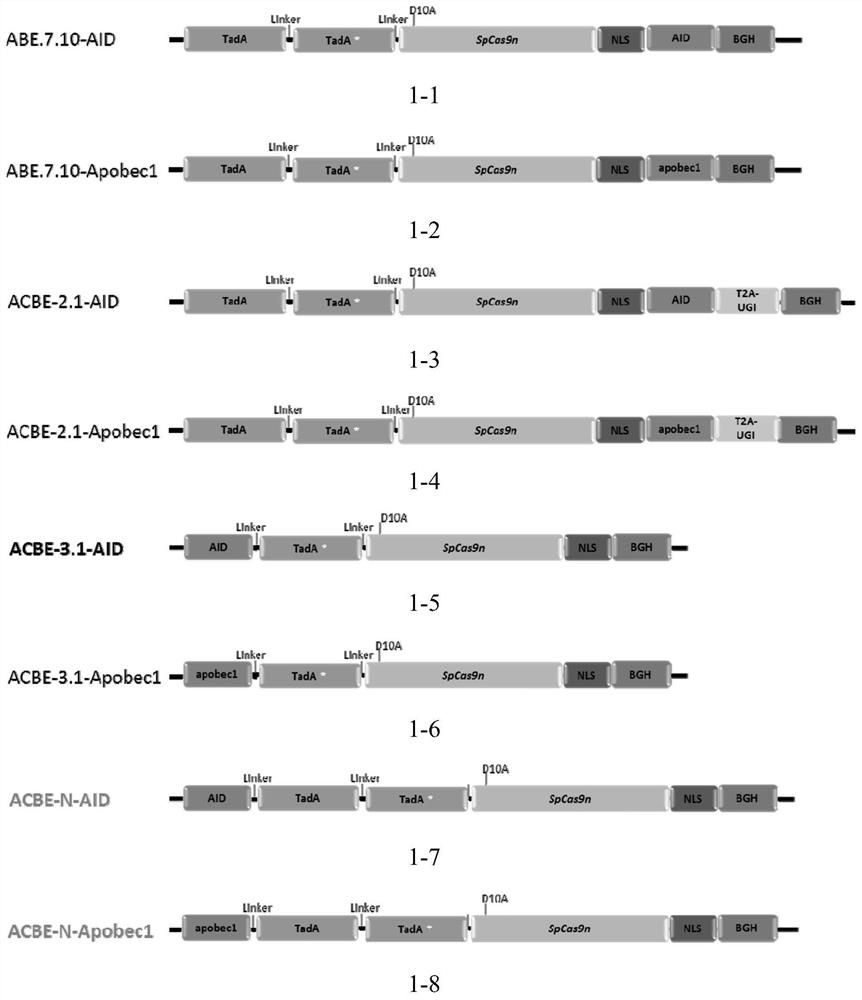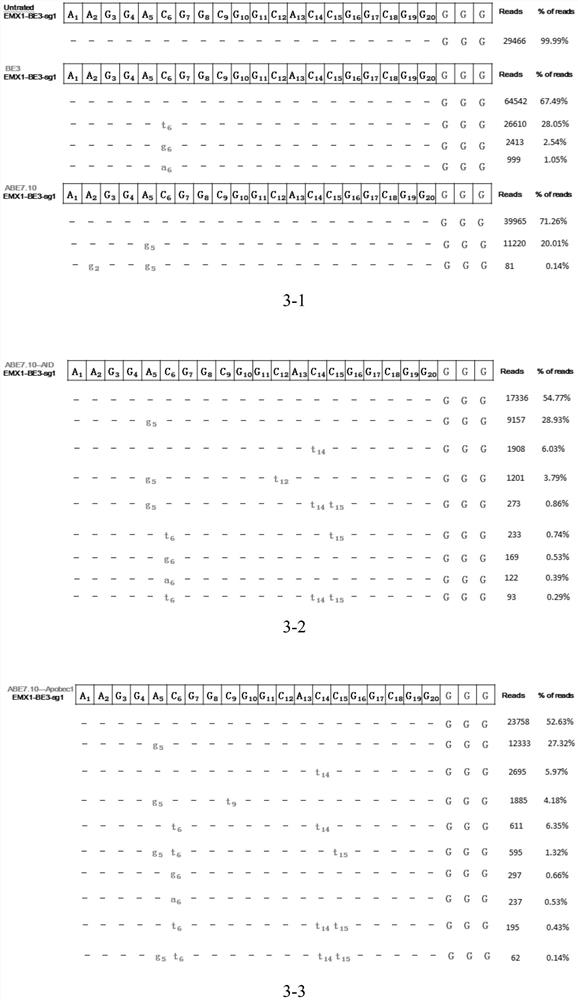Construction method and application of a novel base conversion editing system
A construction method and technology of an editing system, applied in the field of construction of a new type of base conversion editing system, can solve problems such as inability to achieve changes, low activity of adenine deaminase, narrow mutation window of cytosine deaminase, etc., and achieve diverse sex high effect
- Summary
- Abstract
- Description
- Claims
- Application Information
AI Technical Summary
Problems solved by technology
Method used
Image
Examples
Embodiment 1
[0158] Embodiment 1, the construction of the second vector or the second nucleic acid construct
[0159] 1. Target sequences of human loci EMX1, PD-1, VEGFA
[0160] According to the working principle of CRISPR / Cas9 and BE3, ABE7.10, in NCBI, obtain the target of human locus (such as EMX1, PD-1, VEGFA) that both C or A appear in the ACBE window, as shown in Table 1 below shown.
[0161] Table 1. Target sequences of human-derived loci EMX1, PD-1, VEGFA
[0162] target name sequence (5`-3`) EMX1-BE3-sg1 SEQ ID NO. 8 AAGGACGGCGGCACCGGCGGGGG PD-1-sg1 SEQ ID NO.9 CTGCAGCTTCTCCAACACATCGG PD-1-sg2 SEQ ID NO. 10 CAGCAACCAGACCGGACAAGCTGG PD-1-sg3 SEQ ID NO. 11 GGACCGCAGCCAGCCCGGCCAGG PD-1-sg4 SEQ ID NO. 12 CTTCCACATGAGCGTGGTCAGGG VEGFA-sg2 SEQ ID NO. 13 GGCGAGCCGCGGGCAGGGGCCGG
[0163] 2. Design sgRNAoligo according to the target sequence
[0164] The construction of the target plasmid (the target plasmid is the p...
Embodiment 2
[0178] Example 2. Construction of ABE7.10 gene editing vector or nucleic acid construct
[0179] On the basis of ABE7.10 (addgene#102919), AID and Apobec1 were cloned into the C-terminus of ABE7.10 by PCR, and the wild TadA was cloned into the N-terminus of ABE7.10 to obtain as follows: Picture 1-1 and plasmids or constructs shown in 1-2.
Embodiment 3
[0180] Example 3. Design and construction of different base conversion editing systems ACBE
[0181] 1. In Picture 1-1 and Figure 1-2 On the basis of , design other different base conversion editing systems, namely, clone AID and Apobec1 into the C-terminal and N-terminal of ABE7.10 by PCR respectively, or replace the N-terminal wild TadA in ABE7.10, or clone into ABE7.10. C-terminal and then clone a T 2 A-UGI can be obtained as figure 1 plasmids shown. The primers used are shown in Table 3 below:
[0182] Table 3 Primer sequences for constructing different base conversion editing systems
[0183]
[0184]
[0185] 2. Construction of U6-sgRNA-CMV-UGI-T 2 A-GFP
[0186] The primers listed in Table 4 below were used to amplify CMV, UGI, T from BE3 (addgene#73021) and PX458 (addgene#48138) plasmids by PCR. 2 A-GFP, assembled on U6-sgRNA(EcoRV+NotI) plasmid.
[0187] Table 4 Primer sequences for constructing different base conversion editing systems
[0188]
...
PUM
 Login to View More
Login to View More Abstract
Description
Claims
Application Information
 Login to View More
Login to View More - R&D
- Intellectual Property
- Life Sciences
- Materials
- Tech Scout
- Unparalleled Data Quality
- Higher Quality Content
- 60% Fewer Hallucinations
Browse by: Latest US Patents, China's latest patents, Technical Efficacy Thesaurus, Application Domain, Technology Topic, Popular Technical Reports.
© 2025 PatSnap. All rights reserved.Legal|Privacy policy|Modern Slavery Act Transparency Statement|Sitemap|About US| Contact US: help@patsnap.com



